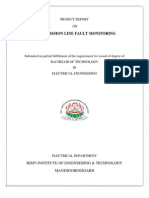Transmission Line Fault Detection Using Wi-FiModule
Uploaded by
SMARTX BRAINSTransmission Line Fault Detection Using Wi-FiModule
Uploaded by
SMARTX BRAINSJournal Publication of International Research for Engineering and Management (JOIREM)
Volume: 10 Issue: 04 | may-2023
Transmission Line Fault Detection Using Wi-FiModule
1
Atharva Chaudhari, 2 Sarvesh Dahiwadkar, 3Aditya Jadhav
Tushar Pandhi
Dr .Deepak Kadam
1Department of electrical Engineering of MET Institute of Engineering, BKC, Nashik,
Abstract:
The fault occurred in transmission line is very much dangerous for the locality. The project presents design and implementation
of a transmission lines monitoring and centralized control system using IOT. In this prototype we design a model which is to be
detect the fault in transmission line by comparing the voltage signal between the transmission line and a reference value, the
reference value is predetermined and if the transmission line voltage is more than or less than reference value then fault is to be
shown in display and send to webpage. A smart fault detection system was used to adequately and accurately indicate what fault
had occurred. The system uses a current transformer, a voltage transformer, arduino and a Wi-Fi module. The system automatically
detects faults, analyses and classifies these faults. Finally, the fault information is transmitted to the control room.
Keyword: Automatic Fault Detection, IOT Technology, Transmission line, Fault Detection, Aurdino, Wi-Fi Module.
I. INTRODUCTION:
Power system is classified into power generation, transmission and distribution. Transmission network is one of the vital parts
of power system, as it connects the supply and the demand. The loss in transmission and distribution network is very high,
compared to other parts of power system. Currently, the electric power infrastructure is highly vulnerable against many forms
of natural and malicious physical events, which can adversely affect the overall performance and stability of the grid. The fault
in the transmission network obstructs the supply of power to the consumer. Hence the transmission network fault identification
and clearance should be very fast. Additionally, there is an impending need to equip the age-old transmission line infrastructure
with a high performance data communication network that supports future operational requirements like real time monitoring
and control necessary for smart grid integration in power transmission systems, most of the voltage and current signal
distortions are caused by faults. Faults that occur in power transmission lines can cause an interruption of power supply. The
time required to locate a fault is drastically reduced, as the system automatically and accurately provides accurate fault
information. This will ensure a shorter response time for technical crew to rectify these faults and thus help save transformers
from damage and disasters. There are many reasons of faults in power transmission leading to power outages, if not properly
managed. Notable among them includes:
• Faults at the power generation station
• Damage to power transmission lines
• Faults at the substations or parts of distribution subsystem
• Lightening
Types of transmission line faults: power system’s faults are categorized as shunt faults or series faults.
• Single line-to-ground fault
• Line-to-line fault
• Line-to-ground fault
Single Line to Ground fault:
The most common type of shunt faults is Single Line-to-ground faults (SLG). This type of fault occurs when one conductor
falls to the ground or gets into contacts with the neutral wire. It could also be the result of falling trees in a rainy storm. This
type could be represented as shown in Fig 1 below.
© 2021, JOIREM |www.joirem.com| Page 1
Journal Publication of International Research for Engineering and Management (JOIREM)
Volume: 10 Issue: 04 | may-2023
Fig 1. Single Line to Ground fault
1. Line to Line Fault:
The second most occurring type of shunt faults is the Line-to-Line fault (LL). This is said to occur when two transmission lines
are short-circuited. As in the case of a large bird standing on one transmission line and touching the other, or if a tree branch
happens to fall on top of two power transmission lines.
Fig 2. Line to Line Fault
2. Double Line-to-Ground Fault:
The third type of shunt fault is the Double Line-to-Ground fault (DLG) in figure below. This can be a result of a tree falling
on two of the power lines, or other causes.
Fig 3. Line to Ground fault
© 2021, JOIREM |www.joirem.com| Page 2
Journal Publication of International Research for Engineering and Management (JOIREM)
Volume: 10 Issue: 04 | may-2023
LITERATURE SURVEY:
Detection of Line-to-Ground and Line-to-Line Faults Based on Fault Voltage Analysis in PV System
The voltage characteristics analysed to develop the LG and LL fault.
The simulation results verify that the proposed technique can detect and locate the LG and LL faults effectively
Automatic Fault Detection in Transmission Lines using Wi-Fi Module
• Faults over transmission line are monitored.
• IOT webpage is used for alert.
• Free IOT servers have limitation for monitoring.
II. PROPOSED SYSTEM:
Fig 1. Proposed System block diagram.
1. ATmega328 Microcontroller:
The ATmega328 is a high-end, feature-rich microcontroller. It is a microcontroller from Atmel's mega MVR
microcontroller’s family. The internal circuitry of the ATmega328 has low current consumption characteristic. The hold
contains 32kB of internal flash memory, 1kB of EEPROM and 2kB of SRAM.
Input Voltage: 7-12V
Input Output Pin: 20
DC Current: 40mA
© 2021, JOIREM |www.joirem.com| Page 3
Journal Publication of International Research for Engineering and Management (JOIREM)
Volume: 10 Issue: 04 | may-2023
Programming Software: Arduino IDE
ESP8266 Wi-Fi Module:
The ESP8266 Wi-Fi Module is a self-contained System on Chip (SOC) with an inbuilt TCP/IP protocol stack that allows any
microcontroller to access your Wi-Fi connection. The ESP8266 may run a Programme or delegate all Wi-Fi networking tasks to
another CPU. JHD162A LCD It's a vivid LCD display that communicates with the microcontroller using the I2C protocol.
Power Supply: +3.3V
Current Consumption:100mA
Range: 10m & 100m with antenna
Works on serial communication protocol
Programmed using AT- Commands
2. Relay:
Relay is an electrically operated switch. Many relays use an electromagnet to mechanically operate a switch, but other operating
principles are also used, such as solid-state relays. Relays are used where it is necessary to control a circuit by a separate low-
power signal, or where several circuits must be controlled by one signal. The first relays were used in long distance telegraph circuits
as amplifiers: they repeated the signal coming in from one circuit and re-transmitted it on another circuit.
Relays were used extensively in telephone exchanges and early computers to perform logical operations. A type of relay that
can handle the high power required to directly control an electric motor or other loads is called a contactor. Solid state relays
control power circuits with no moving parts, instead using a semiconductor device to perform switching. Relays with calibrated
Operating characteristics and sometimes multiple operating coils are used to protect electrical circuits from overload or faults;
in modern electric power systems these functions are performed by digital instruments still called "protective relays". Magnetic
latching relays require one pulse of coil power to move their contacts in one direction, and another, redirected pulse to move
them back. Repeated pulses from the same input have no effect. Magnetic latching relays are useful in applications where
interrupted power should not be able to transition the contacts. When the coil is energized with direct current, a diode is often
placed across the coil to dissipate the energy from the collapsing magnetic field at deactivation, which would otherwise generate
a voltage spike dangerous to semiconductor circuit components.
Such diodes were not widely used before the application of transistors as relay drivers, but soon became ubiquitous as early
germanium transistors were easily destroyed bythis surge. Some automotive relays include a diode inside the relay case. If the
relay is driving a large, or especially a reactive load, there may be a similar problem of surge currents around the relay output
contacts. In this case a snubber circuit (a capacitor and resistor in series) across the contacts may absorb the surge. Suitably rated
capacitors and the associated resistor are sold asa single packaged component for this commonplace use.
Can switch AC/DC
Operating voltage: 5v
Operating current: 100mAmp
Switching supply capacity:
12V DC, 30A
250V AC, 10A
Operating temperature: 0-70 Degree Celsius
© 2021, JOIREM |www.joirem.com| Page 4
Journal Publication of International Research for Engineering and Management (JOIREM)
Volume: 10 Issue: 04 | may-2023
III. CIRCUIT DIAGRAM:
Fig 2. Proposed System Circuit Diagram
IV. RESULT:
The proposed system identifies the fault and displays the fault on the LCD screen and sends the data within fraction of
seconds through IoT to the web page. This helps the operators to locate the fault precisely and send the service man to clear
the fault and restore the power system back into service. The data for every phase can also be recorded for every second and
can be used for data sampling, behaviours of the transmission network for various load flow studies can be analyzed.
V. CONCLUSION:
The model is designed to solve the problems faced by power system. By using such a method, we can easily detect the fault and
resolve it. It is highly reliable and locates the fault in three phase transmission line. It allows to record all the real time data sheets
up to date.
VI. ACKNOWLEDGEMENT:
It was a real pleasure working with mentor, Prof.Tushar Pandhi & HOD Dr.D.P.Kadam for supporting us with the project
work and for helping us to work through the challenges that came up Also, we want to thank the entire departmental staff for
helping us with our project work whenever needed.
© 2021, JOIREM |www.joirem.com| Page 5
Journal Publication of International Research for Engineering and Management (JOIREM)
Volume: 10 Issue: 04 | may-2023
VII. REFERENCES:
[1] Wenchao Miao; Yanfang Luo; Yuchen Liu; Fei Wang, “Detection of Line-to-Ground and Line-to-Line Faults Based onFault
Voltage Analysis in PV System”, 7th International Conference on Power and Renewable Energy (ICPRE), 2022.
[2] Prof. Vikram Singh R. Parihar, “Automatic Fault Detection in Transmission Lines using GSM Technology” International
Journal of Innovative Research in Electrical, Electronics, Instrumentation and Control Engineering, Vol. 6, Issue 4, April 2018.
[3] Manish Khandelwal, Amit “A Review on Transmission Line Faults Detection”, International Journal of Digital
[4] Application & Contemporary Research, Volume 5, Issue 2, September 2016.
[5] Bharathi R, Madhushree M. E, Priyanka Kumari, “Power Consumption Monitoring System using IOT” International.
© 2021, JOIREM |www.joirem.com| Page 6
You might also like
- Project Report-Transmission Line Fault Monitoring76% (21)Project Report-Transmission Line Fault Monitoring34 pages
- Trilogy of Wireless Power: Basic principles, WPT Systems and ApplicationsFrom EverandTrilogy of Wireless Power: Basic principles, WPT Systems and ApplicationsNo ratings yet
- Three Phase Fault Detection System in Transmission SystemNo ratings yetThree Phase Fault Detection System in Transmission System5 pages
- Distribution Line Fault Detection and Intimation Using GSM PDFNo ratings yetDistribution Line Fault Detection and Intimation Using GSM PDF5 pages
- Transmission Line Fault Analysis Using Actuating Relays and Atmega 328P ControllerNo ratings yetTransmission Line Fault Analysis Using Actuating Relays and Atmega 328P Controller6 pages
- Project Final Presentation About Solar PanelsNo ratings yetProject Final Presentation About Solar Panels18 pages
- Tatva Institute of Technological Studies, Modasa Department of Electrical EngineeringNo ratings yetTatva Institute of Technological Studies, Modasa Department of Electrical Engineering33 pages
- Three Phase Fault Detection System in Transmission Line Using Arduino100% (1)Three Phase Fault Detection System in Transmission Line Using Arduino10 pages
- Fault Analysis and Electrical Protection of Distribution Transformer11No ratings yetFault Analysis and Electrical Protection of Distribution Transformer119 pages
- Review On IOT Based Transmission Line Fault DetectionNo ratings yetReview On IOT Based Transmission Line Fault Detection5 pages
- Underground Cable Fault Detection SystemNo ratings yetUnderground Cable Fault Detection System4 pages
- Project Report Transmission Line Fault Monitoring100% (1)Project Report Transmission Line Fault Monitoring34 pages
- An Enhanced Method of Design and Implementation of IotNo ratings yetAn Enhanced Method of Design and Implementation of Iot5 pages
- Availaible at VTU HUB (Android App) : Symmetrical Fault AnalysisNo ratings yetAvailaible at VTU HUB (Android App) : Symmetrical Fault Analysis47 pages
- Wireless Power Theft Monitoring and Controlling UnNo ratings yetWireless Power Theft Monitoring and Controlling Un6 pages
- Underground Cable Fault Distance Detector Using Atmega328 MicrocontrollerNo ratings yetUnderground Cable Fault Distance Detector Using Atmega328 Microcontroller9 pages
- Auto-Recloser Circuit Breaker in Power System Based On Internet of Things For Smart GridNo ratings yetAuto-Recloser Circuit Breaker in Power System Based On Internet of Things For Smart Grid7 pages
- Report - Next Generation Smart Substation Through GSM TechnologyNo ratings yetReport - Next Generation Smart Substation Through GSM Technology70 pages
- Automatic Fault Detection and Location of Transmission Lines Using IoTNo ratings yetAutomatic Fault Detection and Location of Transmission Lines Using IoT5 pages
- Underground Cable Fault Detection and Alert: Sujay S, R Monisha, Prathibha Rekha MurthyNo ratings yetUnderground Cable Fault Detection and Alert: Sujay S, R Monisha, Prathibha Rekha Murthy6 pages
- DESIGN AND CONSTRUCTION OF AN ARDUINO BASED RFID LINE SWITCHING WITH INDIVIDDUAL PHASE SELECTION-Shukrat-1No ratings yetDESIGN AND CONSTRUCTION OF AN ARDUINO BASED RFID LINE SWITCHING WITH INDIVIDDUAL PHASE SELECTION-Shukrat-138 pages
- Detecting Power Grid Synchronization Failure System On Sensing Frequency or Voltage BeyondNo ratings yetDetecting Power Grid Synchronization Failure System On Sensing Frequency or Voltage Beyond5 pages
- Arduino Based Short Circuit Protection SNo ratings yetArduino Based Short Circuit Protection S5 pages
- Modelling and Simulation of Reverse Power Relay For Loss of Mains Protection of Distributed Generation in MicrogridsNo ratings yetModelling and Simulation of Reverse Power Relay For Loss of Mains Protection of Distributed Generation in Microgrids5 pages
- Signal Integrity: From High-Speed to Radiofrequency ApplicationsFrom EverandSignal Integrity: From High-Speed to Radiofrequency ApplicationsNo ratings yet
- Synthesis and Application of Nanomaterials With Future PerspectivesNo ratings yetSynthesis and Application of Nanomaterials With Future Perspectives2 pages
- Design of Agro Waste Bricks for Tribal RegionsNo ratings yetDesign of Agro Waste Bricks for Tribal Regions6 pages
- MITIGATION OF TRANSIENT OVER-VOLTAGE IN MICRO GRID USING SUPERCAPACITOR CONNECTED STATCOMNo ratings yetMITIGATION OF TRANSIENT OVER-VOLTAGE IN MICRO GRID USING SUPERCAPACITOR CONNECTED STATCOM10 pages
- Automatic Power Factor Detection and Correction Using AurdinoNo ratings yetAutomatic Power Factor Detection and Correction Using Aurdino13 pages
- CONTACTLESS DELIVERY ROBOT FOR MEDICAL APPLICATIONNo ratings yetCONTACTLESS DELIVERY ROBOT FOR MEDICAL APPLICATION4 pages
- Inductive charging of ultracapacitor busesNo ratings yetInductive charging of ultracapacitor buses6 pages
- Effectiveness of Artificial Intelligence in Stock Market Prediction Based on Machine LearningNo ratings yetEffectiveness of Artificial Intelligence in Stock Market Prediction Based on Machine Learning8 pages
- DESIGN AND DEVELOPMENT OF 3D PRINTED ROBOTIC ARM FOR PAINTING APPLICATIONNo ratings yetDESIGN AND DEVELOPMENT OF 3D PRINTED ROBOTIC ARM FOR PAINTING APPLICATION7 pages
- Charging of Electric Vehicle using Wireless Power Transmission with Renewable Energy SourceNo ratings yetCharging of Electric Vehicle using Wireless Power Transmission with Renewable Energy Source7 pages
- Feasibility Study of Physical Properties on Concrete Beam using with & without FRP LAMINATENo ratings yetFeasibility Study of Physical Properties on Concrete Beam using with & without FRP LAMINATE9 pages
- Analysis of Property Valuation for Residential BuildingNo ratings yetAnalysis of Property Valuation for Residential Building4 pages
- Comparative Analysis for with & Without Elastomeric Base Isolated Structure Using E-TabsNo ratings yetComparative Analysis for with & Without Elastomeric Base Isolated Structure Using E-Tabs3 pages
- A Study on Financial Statement Analysis with reference to GVK Power & Infrastructure Pvt LtdNo ratings yetA Study on Financial Statement Analysis with reference to GVK Power & Infrastructure Pvt Ltd12 pages
- A REVIEW- AUTO TEMPERATURE DETECTOR FOR ENTRANCE FOR COVID SAFETYNo ratings yetA REVIEW- AUTO TEMPERATURE DETECTOR FOR ENTRANCE FOR COVID SAFETY5 pages
- Battery Temprature Control With Temprature MonitoringNo ratings yetBattery Temprature Control With Temprature Monitoring5 pages
- Review Paper on Design and Analysis of Adaptive Headlight SystemNo ratings yetReview Paper on Design and Analysis of Adaptive Headlight System4 pages
- Microcontroller Based Hand Gloves Dispenser MachineNo ratings yetMicrocontroller Based Hand Gloves Dispenser Machine4 pages
- Once Upon A Brand : Crafting Connections through Storytelling in Modern MarketingNo ratings yetOnce Upon A Brand : Crafting Connections through Storytelling in Modern Marketing11 pages
- Indian Air Quality Prediction and Analysis Using Machine LearningNo ratings yetIndian Air Quality Prediction and Analysis Using Machine Learning5 pages
- Derrick/Mast Inspection Certificate: (API Recommended Practice 4G - 3 Edition 2004 - Sect 9.0)No ratings yetDerrick/Mast Inspection Certificate: (API Recommended Practice 4G - 3 Edition 2004 - Sect 9.0)1 page
- Aa - Req - 000131 - Quality Requirements Third Party Design VerificationNo ratings yetAa - Req - 000131 - Quality Requirements Third Party Design Verification11 pages
- PIPESIM 2011 Training Course Labib Lec 1No ratings yetPIPESIM 2011 Training Course Labib Lec 159 pages
- Lecture 3 - Framework For Project ManagementNo ratings yetLecture 3 - Framework For Project Management51 pages
- DIG The UK BIZ Links W Robert Hunter BidenNo ratings yetDIG The UK BIZ Links W Robert Hunter Biden27 pages
- BMS Upper Computer Guidance V219_241228_055244No ratings yetBMS Upper Computer Guidance V219_241228_05524422 pages
- Trilogy of Wireless Power: Basic principles, WPT Systems and ApplicationsFrom EverandTrilogy of Wireless Power: Basic principles, WPT Systems and Applications
- Three Phase Fault Detection System in Transmission SystemThree Phase Fault Detection System in Transmission System
- Distribution Line Fault Detection and Intimation Using GSM PDFDistribution Line Fault Detection and Intimation Using GSM PDF
- Transmission Line Fault Analysis Using Actuating Relays and Atmega 328P ControllerTransmission Line Fault Analysis Using Actuating Relays and Atmega 328P Controller
- Tatva Institute of Technological Studies, Modasa Department of Electrical EngineeringTatva Institute of Technological Studies, Modasa Department of Electrical Engineering
- Three Phase Fault Detection System in Transmission Line Using ArduinoThree Phase Fault Detection System in Transmission Line Using Arduino
- Fault Analysis and Electrical Protection of Distribution Transformer11Fault Analysis and Electrical Protection of Distribution Transformer11
- Review On IOT Based Transmission Line Fault DetectionReview On IOT Based Transmission Line Fault Detection
- An Enhanced Method of Design and Implementation of IotAn Enhanced Method of Design and Implementation of Iot
- Availaible at VTU HUB (Android App) : Symmetrical Fault AnalysisAvailaible at VTU HUB (Android App) : Symmetrical Fault Analysis
- Wireless Power Theft Monitoring and Controlling UnWireless Power Theft Monitoring and Controlling Un
- Underground Cable Fault Distance Detector Using Atmega328 MicrocontrollerUnderground Cable Fault Distance Detector Using Atmega328 Microcontroller
- Auto-Recloser Circuit Breaker in Power System Based On Internet of Things For Smart GridAuto-Recloser Circuit Breaker in Power System Based On Internet of Things For Smart Grid
- Report - Next Generation Smart Substation Through GSM TechnologyReport - Next Generation Smart Substation Through GSM Technology
- Automatic Fault Detection and Location of Transmission Lines Using IoTAutomatic Fault Detection and Location of Transmission Lines Using IoT
- Underground Cable Fault Detection and Alert: Sujay S, R Monisha, Prathibha Rekha MurthyUnderground Cable Fault Detection and Alert: Sujay S, R Monisha, Prathibha Rekha Murthy
- DESIGN AND CONSTRUCTION OF AN ARDUINO BASED RFID LINE SWITCHING WITH INDIVIDDUAL PHASE SELECTION-Shukrat-1DESIGN AND CONSTRUCTION OF AN ARDUINO BASED RFID LINE SWITCHING WITH INDIVIDDUAL PHASE SELECTION-Shukrat-1
- Detecting Power Grid Synchronization Failure System On Sensing Frequency or Voltage BeyondDetecting Power Grid Synchronization Failure System On Sensing Frequency or Voltage Beyond
- Modelling and Simulation of Reverse Power Relay For Loss of Mains Protection of Distributed Generation in MicrogridsModelling and Simulation of Reverse Power Relay For Loss of Mains Protection of Distributed Generation in Microgrids
- Analog Dialogue, Volume 46, Number 3: Analog Dialogue, #7From EverandAnalog Dialogue, Volume 46, Number 3: Analog Dialogue, #7
- Signal Integrity: From High-Speed to Radiofrequency ApplicationsFrom EverandSignal Integrity: From High-Speed to Radiofrequency Applications
- Synthesis and Application of Nanomaterials With Future PerspectivesSynthesis and Application of Nanomaterials With Future Perspectives
- MITIGATION OF TRANSIENT OVER-VOLTAGE IN MICRO GRID USING SUPERCAPACITOR CONNECTED STATCOMMITIGATION OF TRANSIENT OVER-VOLTAGE IN MICRO GRID USING SUPERCAPACITOR CONNECTED STATCOM
- Automatic Power Factor Detection and Correction Using AurdinoAutomatic Power Factor Detection and Correction Using Aurdino
- CONTACTLESS DELIVERY ROBOT FOR MEDICAL APPLICATIONCONTACTLESS DELIVERY ROBOT FOR MEDICAL APPLICATION
- Effectiveness of Artificial Intelligence in Stock Market Prediction Based on Machine LearningEffectiveness of Artificial Intelligence in Stock Market Prediction Based on Machine Learning
- DESIGN AND DEVELOPMENT OF 3D PRINTED ROBOTIC ARM FOR PAINTING APPLICATIONDESIGN AND DEVELOPMENT OF 3D PRINTED ROBOTIC ARM FOR PAINTING APPLICATION
- Charging of Electric Vehicle using Wireless Power Transmission with Renewable Energy SourceCharging of Electric Vehicle using Wireless Power Transmission with Renewable Energy Source
- Feasibility Study of Physical Properties on Concrete Beam using with & without FRP LAMINATEFeasibility Study of Physical Properties on Concrete Beam using with & without FRP LAMINATE
- Analysis of Property Valuation for Residential BuildingAnalysis of Property Valuation for Residential Building
- Comparative Analysis for with & Without Elastomeric Base Isolated Structure Using E-TabsComparative Analysis for with & Without Elastomeric Base Isolated Structure Using E-Tabs
- A Study on Financial Statement Analysis with reference to GVK Power & Infrastructure Pvt LtdA Study on Financial Statement Analysis with reference to GVK Power & Infrastructure Pvt Ltd
- A REVIEW- AUTO TEMPERATURE DETECTOR FOR ENTRANCE FOR COVID SAFETYA REVIEW- AUTO TEMPERATURE DETECTOR FOR ENTRANCE FOR COVID SAFETY
- Battery Temprature Control With Temprature MonitoringBattery Temprature Control With Temprature Monitoring
- Review Paper on Design and Analysis of Adaptive Headlight SystemReview Paper on Design and Analysis of Adaptive Headlight System
- Microcontroller Based Hand Gloves Dispenser MachineMicrocontroller Based Hand Gloves Dispenser Machine
- Once Upon A Brand : Crafting Connections through Storytelling in Modern MarketingOnce Upon A Brand : Crafting Connections through Storytelling in Modern Marketing
- Indian Air Quality Prediction and Analysis Using Machine LearningIndian Air Quality Prediction and Analysis Using Machine Learning
- Derrick/Mast Inspection Certificate: (API Recommended Practice 4G - 3 Edition 2004 - Sect 9.0)Derrick/Mast Inspection Certificate: (API Recommended Practice 4G - 3 Edition 2004 - Sect 9.0)
- Aa - Req - 000131 - Quality Requirements Third Party Design VerificationAa - Req - 000131 - Quality Requirements Third Party Design Verification













































































































